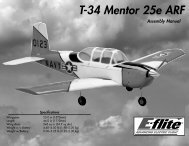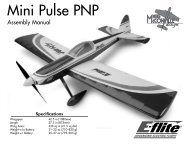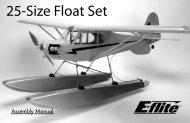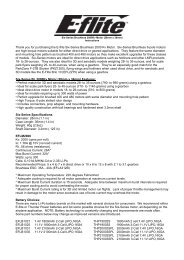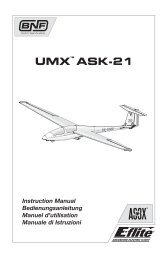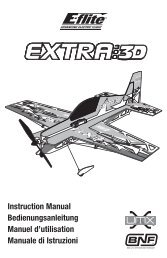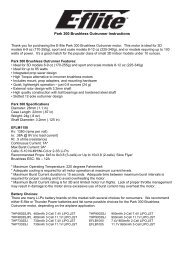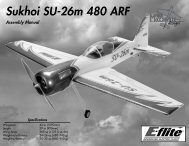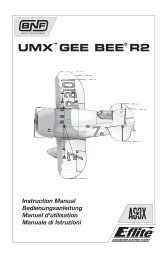Ascent 450 BL Park Glider PNP - E-flite
Ascent 450 BL Park Glider PNP - E-flite
Ascent 450 BL Park Glider PNP - E-flite
You also want an ePaper? Increase the reach of your titles
YUMPU automatically turns print PDFs into web optimized ePapers that Google loves.
• Pitch Attitude<br />
In-Flight Adjustments for<br />
Performance and Conditions<br />
• Minimum Sink Speed<br />
• Maximum Lift/Drag (L/D) Speed<br />
Pitch Attitude<br />
To determine the <strong>Ascent</strong>’s airspeed, you will have to watch<br />
carefully for its pitch attitude. Pitch attitude can best be described<br />
as the amount (degree) the nose of the aircraft is above or below<br />
a line relative to the horizon. The angle of attack term is used to<br />
describe the angle between the chord (width) of the wing and the<br />
direction the wing moves through the air.<br />
• Best Penetration Speed<br />
Once the fundamentals of launch, trim, and control of the <strong>Ascent</strong><br />
are learned, it's time to consider getting the most out of its ability<br />
to perform. To do that, you must learn how to trim your <strong>Ascent</strong> for<br />
maximum performance, whatever the current conditions are at the<br />
time. The key to trimming for maximum performance is to become<br />
knowledgeable of three key speeds: minimum sink, maximum lift/<br />
drag (L/D), and best penetration.<br />
These three speeds are what we call airspeeds, not ground<br />
speeds (the aircraft's speed across the ground). Thus the airspeed<br />
of the plane is relative to the air mass surrounding it.<br />
Longitudinal<br />
Axis<br />
Pitch<br />
Attitude<br />
Line Relative to Horizon<br />
Horizon<br />
Nose<br />
Center of<br />
Gravity<br />
E-<strong>flite</strong> <strong>Ascent</strong> <strong>PNP</strong> Assembly Manual<br />
23



